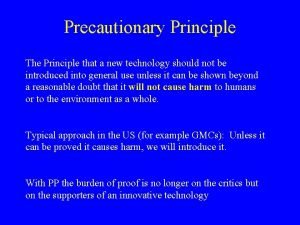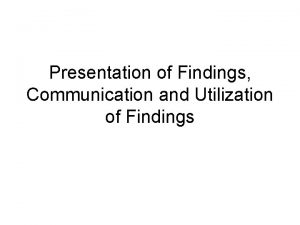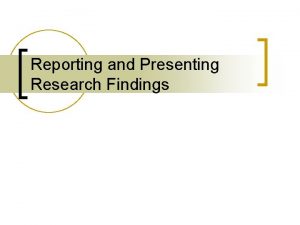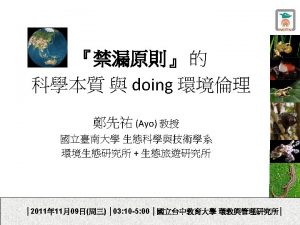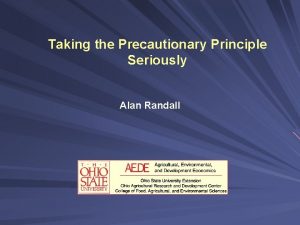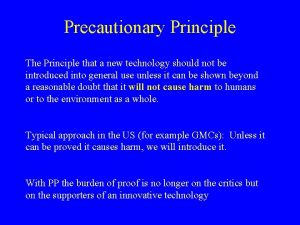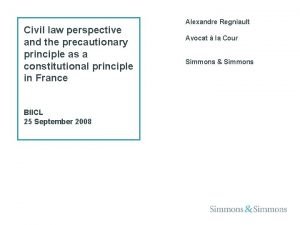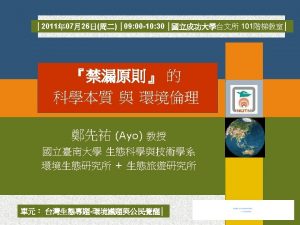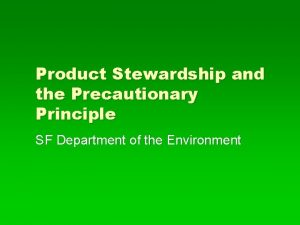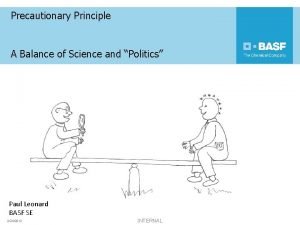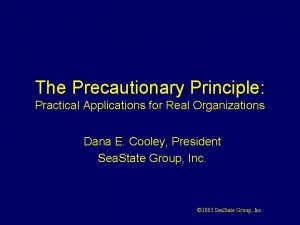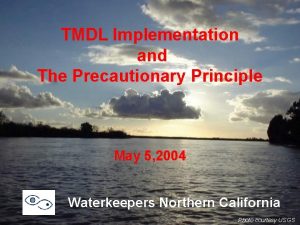The Precautionary Principle social research findings presentation Prepared



























- Slides: 27

The Precautionary Principle – social research findings presentation Prepared by Edelman Intelligence – June 6 th 2016

Contents Objectives and Methodology 3 Key Findings 7 Limited awareness of the Precautionary Principle - ethos resonates as a guideline 8 Risk is inevitable, so it needs to be well understood to be accepted 10 Risk management is important 17 Who should manage the risk? 19 No consistency with the application of the Precautionary Principle 22 Key Takeaways 17/06/2021 2 The Precautionary Principle 25

Objectives and Methodology

Objectives of the social research Edelman Intelligence was commissioned by Syngenta to conduct further research on consumers’ attitudes towards the Precautionary Principle in the UK, Germany and France. The objectives of the research were to: • Test awareness of, and attitudes towards the Precautionary Principle among consumers • Uncover their views on the clarity of the Principle and the consistency of its application • Analyse which examples (both from the Cranfield paper and elsewhere) of the Principle resonate most with respondents and why 17/06/2021 4 The Precautionary Principle

Audiences and methodology What A total of 66 individuals from a mix of ages, genders and social groups participated in the research. Who When 33 Concerned Consumers (defined as higher educated, active in community issues and interested in a range of societal issues) 33 General Public Fieldwork was conducted between December 2014 and January 2015. Where 17/06/2021 6 x Qualitative discussion groups 6 x Qualitative triad groups London 5 The Precautionary Principle Paris Frankfurt

Definition of the Precautionary Principle and examples used to bring it to life In this research the following explanation of the Specific case studies relevant at the time of fieldwork Principle was provided: were used to bring the issue to life: “It is a term which means that when there is a potential risk, and where scientific Ebola & the outbreak of disease Genetically modified food Fracking & energy Climate change Mobile communications and potential link to brain tumours evidence might not be complete, we should err on the side of caution i. e. we should completely avoid doing something. ” To debate the Principle, participants were tasked with role playing the scenarios from three perspectives: Government 17/06/2021 6 The Precautionary Principle Business NGOs

Key Findings

Key Findings 1. Limited awareness of the Precautionary Principle - ethos resonates as a guideline 2. Risk is inevitable, so it needs to be well understood to be accepted 3. Risk management is important 4. Who should manage the risk? 5. No consistency with the application of the Precautionary Principle 17/06/2021 8 The Precautionary Principle

Limited awareness of the Precautionary Principle - ethos resonates as a guideline Have you heard of the term before? “Yes; we didn’t say it, we didn’t call it like that, but it was implied. ” Concerned Consumer, Paris “I have never heard of it before. ” Concerned Consumer, Frankfurt The risk of inaction as well as action is clear It is acknowledged that the Principle does come with benefits: getting more perspective, information and time to carry out some tests. However, people also agree that we can miss out on opportunities when the Principle is relied upon. Indeed, decisions take longer to make and the consequence of a delayed decision-making process is that other countries get ahead and end up being in better economic shape and seen as more innovative. 17/06/2021 9 The Precautionary Principle

Key Findings 1. Limited awareness of the Precautionary Principle - ethos resonates as a guideline 2. Risk is inevitable so it needs to be well understood to be accepted 3. Risk management is important 4. Who should manage the risk? 5. No consistency with the application of the Precautionary Principle 17/06/2021 10 The Precautionary Principle

There are multiple factors influencing the perception of risk… CONTEXT Risk IMPACT GUIDANCE 17/06/2021 11 The Precautionary Principle KNOWLEDGE AND EMPOWERMENT EVIDENCE

There are multiple factors influencing the perception of risk… INDIVIDUAL CIRCUMSTANCES BENEFIT vs. RISK CONTEXT Risk IMPACT GUIDANCE 17/06/2021 12 The Precautionary Principle KNOWLEDGE AND EMPOWERMENT EVIDENCE

There are multiple factors influencing the perception of risk… CONTEXT TRANSPARENT INFORMATION Risk IMPACT KNOWLEDGE AND EMPOWERMENT BEING INFORMED / EMPOWERED GUIDANCE 17/06/2021 13 The Precautionary Principle EVIDENCE

There are multiple factors influencing the perception of risk… CONTEXT Risk IMPACT GUIDANCE KNOWLEDGE AND EMPOWERMENT EVIDENCE STRENGTH OF EVIDENCE 17/06/2021 14 The Precautionary Principle SCIENTIFIC EVIDENCE VS. SPECULATION

There are multiple factors influencing the perception of risk… CONTEXT Risk IMPACT AUTHORITATIVE GUIDANCE MAINSTREAM OPINION 17/06/2021 15 The Precautionary Principle KNOWLEDGE AND EMPOWERMENT EVIDENCE

There are multiple factors influencing the perception of risk… CONTEXT VULNERABILITY EXPOSURE TO ME VS. OTHERS IMPACT Risk GUIDANCE 17/06/2021 16 The Precautionary Principle KNOWLEDGE AND EMPOWERMENT EVIDENCE

Key Findings 1. Limited awareness of the Precautionary Principle - ethos resonates as a guideline 2. Risk is inevitable so it needs to be well understood to be accepted 3. Risk management is important 4. Who should manage the risk? 5. No consistency with the application of the Precautionary Principle 17/06/2021 17 The Precautionary Principle

As risk is accepted, management of that risk is more important Respondents perceive risk to be an accepted element of daily life but management of risk entails different actions: Get the Full Picture • Independent experts Citizens feel safer when they know independent organisations (free from agenda) have assisted in the decision-making process. • Learning by example - consulting with countries that have already gone through the process and can provide first-hand knowledge of the situation and potential watch outs. 17/06/2021 18 The Precautionary Principle Measurement of Risk Minimisation of Risk • Measuring risk - understanding what percentage of actual risk exists. • Isolating risk – E. g. not fracking near populated areas. • Testing - People want thorough scientific, economic tests to be undertaken for a critical period of time. • Ensuring ‘acceptable risk’ – risk which threatens human / animal life is too much but minimal risk outside of this is accepted. • Continual Monitoring – Respondents also called for regular monitoring of the situation and to publish these measurements. • Minimising risk to the most vulnerable – E. g. children, the elderly.

Key Findings 1. Limited awareness of the Precautionary Principle - ethos resonates as a guideline 2. Risk is inevitable so it needs to be well understood to be accepted 3. Risk management is important 4. Who should manage the risk? 5. No consistency with the application of the Precautionary Principle 17/06/2021 19 The Precautionary Principle

Complex relationship between key decision makers “I would be convinced by an NGO, organisations that are taking care of it with politics [that considers] us. ” Concerned Consumer, Frankfurt NGOs Business 17/06/2021 20 The Precautionary Principle Government “Companies are not in a good position, as they have no idea how to manage the risks, they lie. ” Concerned Consumer, Paris “The government has got to approve it. The business can't just approve it and say, 'Well it's out there. ' Concerned Consumer, London

The ideal framework of responsibility should inform consumers to make the right decisions – ultimately they want to have the final say Trusted organisations, providing moral guidance to business and governments. However, there is some recognition that they too have agendas. NGOs Business Government Expected to protect the needs and ensure the safety of their citizens. They make informed decisions but there is recognition of the power businesses have on them. “The Influencers” “The Protectors” Consumers “The Decision Makers” 17/06/2021 21 The Precautionary Principle Businesses are seen as influencing governments directly, and consumers with their products and services. However, in this era of transparency, consumers would know if businesses step out of line. “The Moral Code” Consumers recognise the influence of big businesses but feel that governments are looking out for them. Ultimately, consumers want to be the main decision makers. Governments have to ensure a certain level of safety.

Key Findings 1. Limited awareness of the Precautionary Principle - ethos resonates as a guideline 2. Risk is inevitable so it needs to be well understood to be accepted 3. Risk management is important 4. Who should manage the risk? 5. No consistency with the application of the Precautionary Principle 17/06/2021 22 The Precautionary Principle

General consensus is that there is no consistency with the application of the Precautionary Principle Country implementation differs too much - Risk taking / risk averse countries “The Northern [European] countries, Sweden, Norway and Finland especially due to their focus on environmental protection. ” General Public, Frankfurt - Developing countries / mature economies - Culture “The US are rather pro-risk!” General Public, Paris Sector implementation differs too much - Direct impact on human lives (i. e. healthcare, childcare, caring for the elderly - None direct impact on human lives (i. e. technology) 17/06/2021 “In Third World countries where there is a lot of poverty. . the government has to act, they don’t ask anyone they just do. ” Concerned Consumer, Frankfurt 23 The Precautionary Principle [What are the populations for which we don’t take any chances? ] “The elderly. Pregnant women. ” General Public, Paris “As other people have said, the different thing would be your children, then you kind of take a bit more of a cautious approach. ” General Public, London

Clear need for individual countries to make their own decisions Global concern – Local decision making People recognized the fact that risks can have broad impacts (spread of epidemics like Ebola, large scale water contamination with fracking) and therefore raise local, national and international concerns but they also want to be able to make their own decisions locally (e. g. in associations). Many people were unaware that individual countries were governed to a certain degree by other countries and EU regulation. 17/06/2021 24 The Precautionary Principle “If we want to be locally represented, we create an association, and we elect a representative. ” Concerned Consumer, Paris “Obviously we want to be able to trade freely with these people across Europe but still want to make the local decisions for ourselves” General Public, London “I think we should have our own rules and regulations and not listen to what's going on in Europe”. General Public, London “I didn't even realise that was the case, I just thought that each country made their own rules and regulations” General Public, London

Key Takeaways

Key Takeaways • The exact terminology of the Precautionary Principle is not well known, although many were familiar with the idea behind the Principle. • Consumers want the application of the Principle to be dependent on the situation in question. The Principle was seen as a guideline but not one that dictates all regulation. • The main concerns were that the Principle would slow down decision making and thus impact innovation. In France, there was a particular concern about the risk of inaction and falling behind other countries as a result. • It was understood that a range of decision makers should be responsible for assessing and managing risk. Respondents understood that a nuanced relationship between government, businesses, NGOs and consumers exists. It was felt that the best way of assessing and managing risk is to have voices heard from all institutions in addition to independent experts (free from economic or political motive). • Consumers accept that all situations will have an element of risk. In an ideal situation, they would want all parties to be assessing risk and ensuring a certain level of safety for them but they want to have the final decision. 17/06/2021 26 The Precautionary Principle

Thank you
 Precautionary principle
Precautionary principle Precautionary principle
Precautionary principle Precautionary principle
Precautionary principle Example of biological hazard
Example of biological hazard Precautionary principle
Precautionary principle Precautionary principle
Precautionary principle Precautionary principle
Precautionary principle Sds stands for whmis
Sds stands for whmis Presentation of results
Presentation of results Findings of qualitative research
Findings of qualitative research Findings example in research
Findings example in research Findings in research
Findings in research Instruments in quantitative research
Instruments in quantitative research Results and discussion in research
Results and discussion in research Qualitative quantitative
Qualitative quantitative Example of applied research
Example of applied research Translating research findings to clinical nursing practice
Translating research findings to clinical nursing practice Students diversity in motivation
Students diversity in motivation Reporting research findings
Reporting research findings Presenting research findings
Presenting research findings Social thinking and social influence in psychology
Social thinking and social influence in psychology Social thinking social influence social relations
Social thinking social influence social relations External neck anatomy
External neck anatomy Why is tactile fremitus decreased in pleural effusion
Why is tactile fremitus decreased in pleural effusion Causes of rickets
Causes of rickets Conncets
Conncets Costophrenic angle tenderness
Costophrenic angle tenderness Acute interstitial nephritis urine findings
Acute interstitial nephritis urine findings




